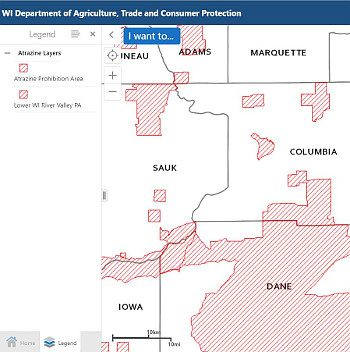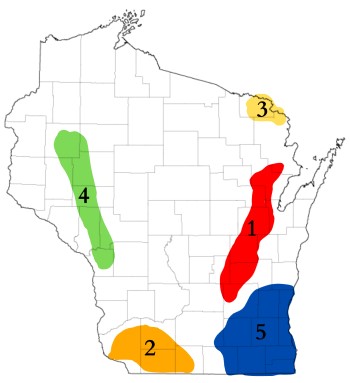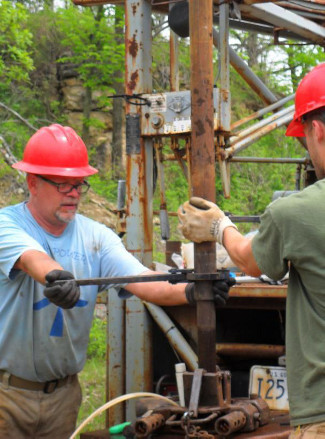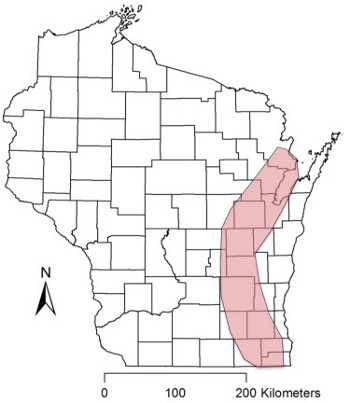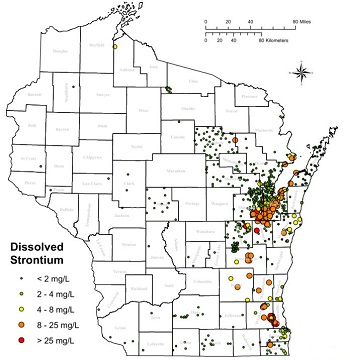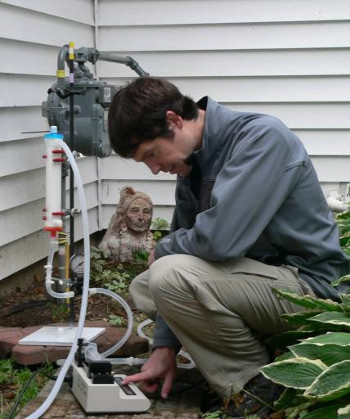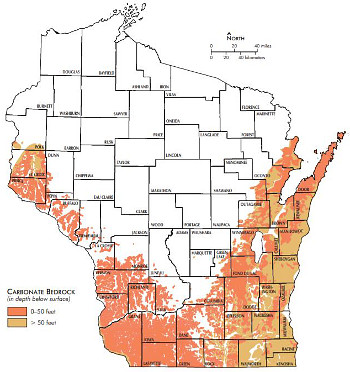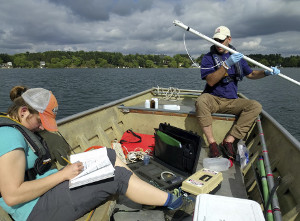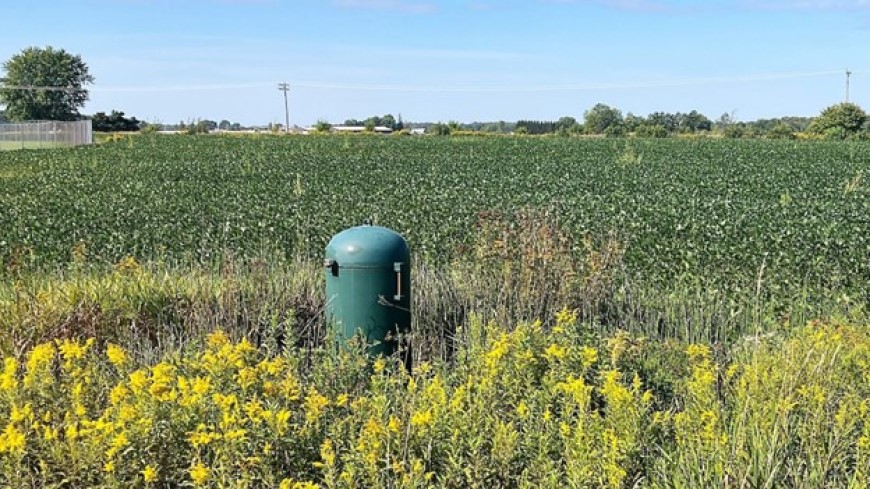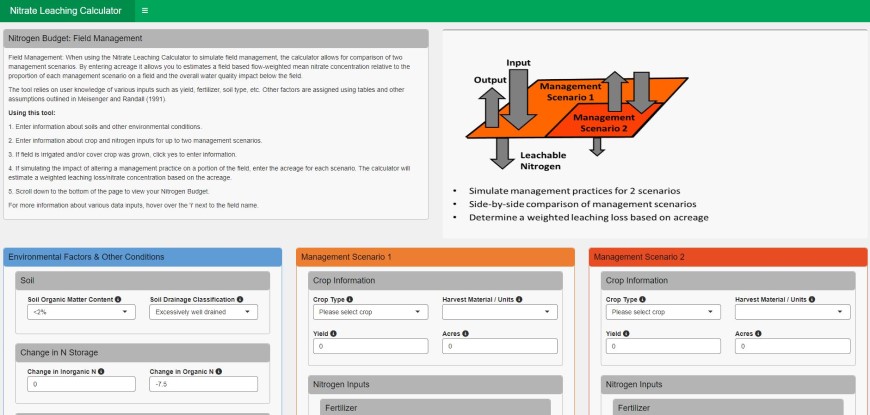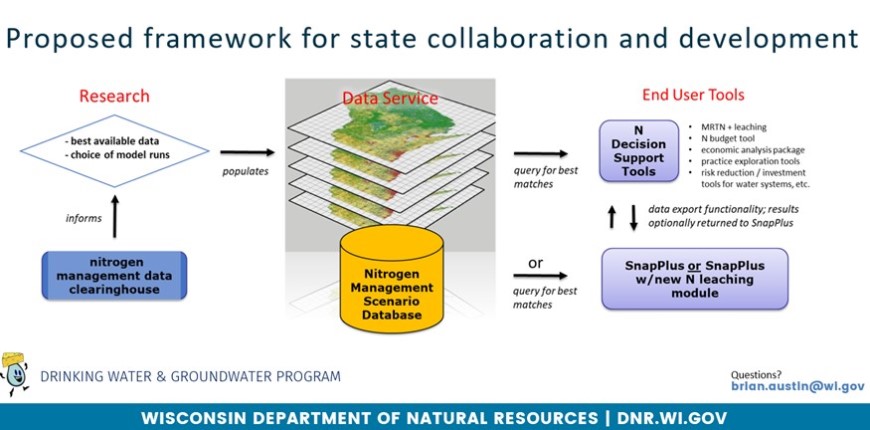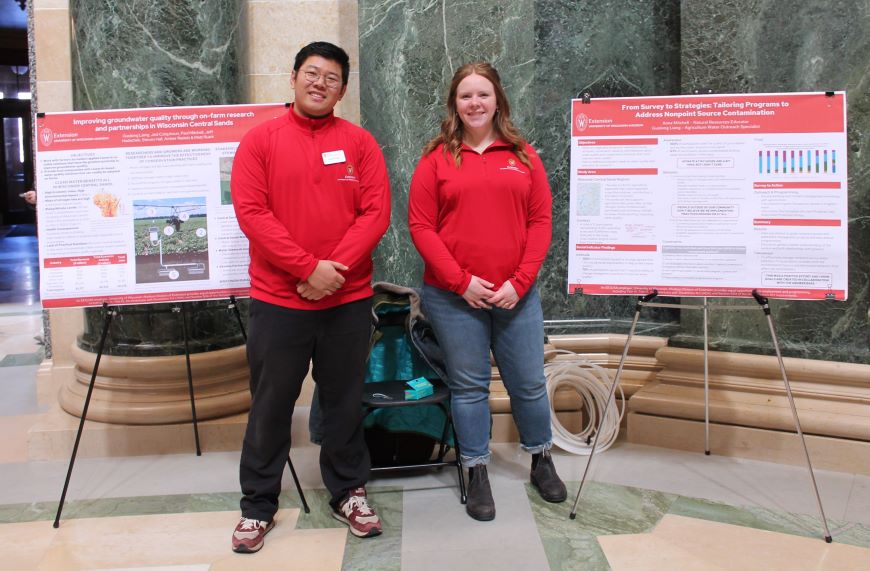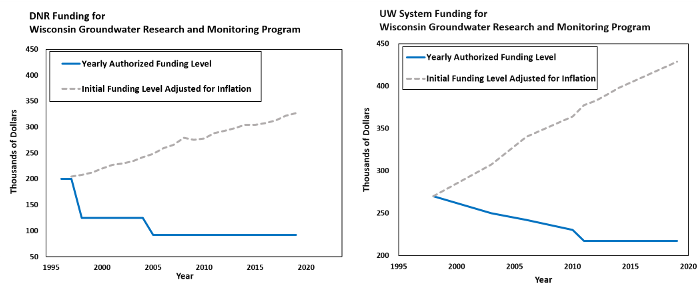Groundwater Coordinating Council And Agency-Funded Research Highlights
Groundwater Coordinating Council Report to the Legislature
Projects funded by the Groundwater Coordinating Council (GCC), state agencies and the UW have provided valuable information regarding Wisconsin's groundwater resources, helped evaluate existing programs, increased the knowledge of the movement of contaminants in the subsurface and developed new methods for groundwater evaluation and protection.
GCC-Funded Research
GCC-Funded Research
A complete compilation of all GCC-funded projects can be found at UW Water Resources Institute's searchable repository. While the application of the results is broad, some areas where the results of state-funded groundwater research and monitoring projects have been successfully applied to groundwater problems in Wisconsin include the following:
Pesticidesof Atrazine Prohibition Areas in Wisconsin. Photo credit: DATCP. Background
Outcomes
Learn More |
ArsenicWisconsin (regions 1 & 3), but is also found in other areas throughout the state (regions 2, 4 & 5). Background
Outcomes
Learn More |
NitrateNitrate Standard by County. Background
Outcomes
Learn More |
Viruses, Bacteria and Pathogenswell casing during a GCC-funded experiment designed to improve understanding of virus transport from wastewater to drinking water wells. Photo credit: Blake Russo-Nixon. Background
Outcomes
Learn More |
Radium and other Naturally Occurring Elementsexceed the drinking water MCL for radium are located. This band coincides with where the Cambrian-Ordovician sandstone aquifer intersects the Maquoketa shale. Figure: Luczaj and Masarik, 2015. Background
in Wisconsin's aquifers. © Luczaj et al., 2013 Outcomes
Learn More |
Innovative lab methodsScience, collects a well water sample from a residential home to analyze using new MST tools. Photo credit: Carolyn Betz, UW ASC. Background
Outcomes
|
MethylmercuryBackground
Outcomes
Learn More |
Fracture flow and karstthe land surface are particularly vulnerable to groundwater contamination. Photo credit: WGNHS. Background
Outcomes
Learn More |
Groundwater/surface water interactionsthe study lakes and from nearby monitoring wells to understand groundwater-surface water interactions. DNR staff collecting water quality on Pleasant Lake. Background
Outcomes
Learn More |
Emerging Groundwater ContaminantsBackground
Outcomes
Learn More |
Agency-Funded Research
Agency-Funded Research
Nitrate Initiatives
Multiple sampling programs have been carried out by the DNR, DATCP and the WGNHS to characterize the extent of nitrate contamination.
In addition to regular well sampling surveys performed by DATCP, DATCP supports the development of nutrient management plans (NMPs). These plans specify the amount and timing of nutrient sources applied to a field to optimize economic input. Approximately 31% of the agricultural land in Wisconsin is covered by an approved management plan 28. All farms that apply nutrients to fields, including pastures, are required to have a nutrient management plan. DATCP provides financial assistance, free resources and training for farmers to encourage total coverage across the state.
DATCP estimated that in 2007, over 200 million pounds of nitrogen were applied to agricultural lands in excess of UW recommendations, a number that could be substantially reduced with broader adoption of NMPs. However, NMPs do not presently contain mechanisms specifically designed to assess potential nitrate losses below the root zone and the impacts to groundwater.
Numerous studies indicate that NMPs are not always effective at reducing nitrate levels to below the MCL. Even in the best-managed agricultural systems, substantial amounts of nitrogen fertilizer bypass the root zone and is leached to groundwater, which makes it likely that even for current agricultural management practices, groundwater concentrations of nitrate-N at or above the MCL will continue to be a concern for Wisconsin residents1,2,3,15,16,19,20,22,24. Nonetheless, there is still significant potential for improvement through increased adoption of NMPs, particularly if plans are specifically designed to result in less potential for nitrate leaching by incorporating crops into rotation that require less nitrogen inputs, keeping nitrogen inputs at the lower end of recommended ranges, the use of cover crops and utilizing perennial cropping practices24.
The Nitrate Pilot Projects
The Nitrate Pilot Project program was started by the DNR Drinking Water and Groundwater Program in 2012 to develop partnerships with drinking water stakeholders, including the agricultural community, to evaluate strategies to reduce nitrate loading to groundwater while maintaining farm profitability. Projects have been established in collaboration with communities where municipal water systems were approaching unsafe levels of nitrate contamination. Key partners include the Wisconsin Rural Water Association, the UW System, WGNHS, the Wisconsin Land and Water Conservation Association, County Conservation and County Environmental Health departments, the USGS and others.
negatively affects groundwater quality in the well. Photo credit: Josh Soyk-Abbotsford City Administrator.
Common themes and challenges have emerged when looking at the potential for land use changes in the vicinity of wells. Because nitrate is an acute contaminant, regulators, water suppliers and consumers need assurances that any mitigation efforts will be robust and reliable enough to assure a safe concentration of nitrate at the tap. Stakeholders need to know which conservation practices can achieve the needed water quality results, how intensively practices need to be applied and the associated costs and timeframes to achieve the desired benefits. In many cases, data on the efficacy of practices for protecting groundwater is either lacking or involves significant degrees of variability in the expected results. Better tools to assist with formulation of the NMPs and conservation practice regimes that will be protective of drinking water wells located downgradient of agricultural fields are needed. Stakeholders also need to know the time period or “lag” that can be expected between implementing practices in the field and the onset of water quality improvements at the tap. Traditional nutrient management planning and even typical wellhead protection planning are not designed or equipped to answer these questions.
This has led to the recommendation for the state, on a collaborative basis with all drinking water stakeholders, to engage in a process to develop new tools to facilitate protection of our sources of drinking water while maintaining profitable agricultural production. The goal is to enable local resource managers to partner with producers to implement new “groundwater protective” nutrient management plans, particularly in areas contributing recharge to potable wells.
Groundwater And Nitrogen Fertilizer Decision Support Tools
To help achieve groundwater protection in the context of nutrient management planning, the DNR is presently working with USGS and UW system partners to develop a series of Groundwater and Nitrogen Fertilizer Decision Support tools (GW & Nitrogen DSTs) for use by communities needing source water protection resources, conservation departments, the agricultural community, and other drinking water stakeholders. Nitrogen fertilizer decision support tools will be developed and improved over time based on contributions from a range of stakeholders. The goal is to create tools that are complementary to the existing Nutrient Management programming in the state, and that will illuminate management options that better protect groundwater while maintaining agricultural profitability. Starting with basic tools and progressing to more advanced applications over time, stakeholders are being engaged to develop collaborative solutions to address data and research gaps, as well as barriers to adoption. Early products focus on intuitive solutions, including nitrogen budget calculators that help with estimation of average annual leaching potential based on the difference between nitrogen inputs and outputs to the cropping system21. An example is the online application developed by the Central Wisconsin Groundwater Center that uses a simple mass balance approach, and also allows the user to apply nutrient credits for nitrate contained in applied irrigation water26. With basic user supplied inputs (i.e., N fertilizer, yield, soil characteristics, etc.) the tools will estimate the potential leachable nitrogen. Early evaluation shows that the calculator provides realistic results, especially for coarse textured soils, such as in the Central Sands region where the challenge of estimating the change in nitrogen storage in soil is less critical12,25,27. Features that can aid in planning to reduce leaching potential include the option to account for nitrogen in irrigation water, adding cover crops, and the ability to compare the effect of varying fertilizer rates.
- Beta version of the calculator.
- Video presentation discussing the use of the nitrogen budget leaching estimation tool at field and regional scales
Future updates will utilize outputs from process-based models to increase realism and insight by incorporating nitrogen cycle drivers and the effects of weather variability17,18. In source water protection areas where mitigation of nitrate impacts to groundwater is needed, the idea is to couple an analysis of practices to reduce nitrate leaching potential with the existing nutrient management planning tools already in use in Wisconsin. For example, to explore options to reduce nutrient losses, a user might export nutrient management data from Wisconsin’s SnapPlus nutrient management planning software and process separately with a Nitrogen Decision Support Tool. Alternatively, future versions of SnapPlus could be coded to include scripts that calculate potential nitrogen losses by pulling in needed data from a central nitrogen management scenario database. The Nitrogen Management Scenario Database would be pre-populated with the best available data from field trials, the scientific literature and model runs that simulate the crop growth and nutrient leaching effects of management practice options and weather variations.
Because the nitrogen cycle is complex and many factors lead to nitrogen losses, we expect some nitrate leaching to occur even under optimal management, especially for nitrogen-demanding crops4-10. The goal is to provide reasonable expected ranges of the nitrate leaching below the root zone for common practices and to provide estimates of loss reductions for proposed conservation practices. By coupling loss estimates with groundwater transport DSTs, we can facilitate groundwater management to ensure potable wells located hydraulically downgradient in production fields can be maintained below the health-based standard for nitrate. To achieve the dual goal of source water protection and farm profitability, we must also quantify any tradeoffs in productivity. Where economic offsets can be expected to occur, bracketing such offsets could serve as a basis for utilizing state and federal conservation practice funding sources in new ways that protect drinking water sources and public health while enhancing local economies.
To upgrade the state’s capacity to reduce nitrogen losses and protect the health of most of the state population that relies on groundwater for drinking water, the goal is to better understand the extent of losses from current practices and illuminate options to reduce them. Concurrently, groundwater decision support tools in development will assist resource managers with identifying critical land areas based on outputs from groundwater flow models and address common questions, such as the estimated time delay between practice implementation and expected water quality improvements at receptors11,13,14. Groundwater DSTs will leverage existing research and groundwater models to make hydrogeologic information more available to decision-makers23. Ultimately, these tools will help better utilize existing state and federal non-point pollution funding for conservation practices and can be incorporated into traditional watershed-based planning and implementation.
This long-term project provides a framework for the continued development and improvement of groundwater and nitrogen decision support as additional partners, research and data are incorporated over time. To be successful, all drinking water stakeholders, including the agricultural community, will need to share ownership and responsibility for the continued development and improvement of these tools, just as we continually develop and improve the science supporting crop production. The integration of partners within a coordinated statewide research, planning, outreach, and implementation framework is necessary to address the range of challenges of preventing excess nitrogen losses to our waters. The current Groundwater and Nitrogen Decision Support Tool development partnership seeks to expand collaboration with agencies, researchers, outreach specialists, decision support application developers and agricultural producers.
Learn more
- Abbotsford Pilot Project
- Video: Pilot project modeling analysis presentation to the Waupaca Common Council (starts at 1:01:42)
- A Groundwater-Flow Model and Effective Nitrate Calculator for Waupaca, Wisconsin
- Webinar: Nitrogen leaching in central sands: Regional & field-based estimation
- Video: Presentation on the Nitrogen Fertilizer Decision Support Tools project (starts at 41:33)
DATCP Surface And Groundwater Monitoring
Wisconsin DATCP performs routine monitoring for pesticides and nitrates to evaluate the occurrence of agrichemicals in surface water and groundwater. DATCP's Bureau of Laboratory Services analyzes samples for nitrate and more than 100 pesticide compounds using modern analytical methods. Sample collection and analysis have no cost for well owners. Annual summary reports of surface and groundwater monitoring programs are posted online.
Monitoring Programs
- Targeted Sampling Program: Tests groundwater from private wells in agricultural areas around the state to determine if pesticides are present and at what concentrations. Areas with an elevated risk for impact by agricultural chemicals are sampled annually. Samples are collected by DATCP and analyzed by DATCP's Bureau of Laboratory Services. Results are shared with the well owners and local county conservation departments, and they are used to evaluate new policy development.
- Field-Edge Monitoring Program: This program analyzes groundwater samples from monitoring wells installed within or near agriculture fields to evaluate whether agricultural practices are affecting groundwater quality. DATCP collaborates with growers around the state to install and maintain a network of groundwater monitoring wells. Groundwater collection occurs multiple times a year over several years to evaluate pesticide concentrations and potential trends. Observations and results help shape future policy and standards development.
- Surface Water Sampling Program: Represents a collaboration with the Wisconsin Department of Natural Resources (DNR) stream sampling programs. This program provides pesticide analyses on select stream streams typically located within agricultural or urban areas where pesticides are used. Samples are collected by DNR and DATCP, and analyzed by DATCP's Bureau of Laboratory Services. Data is used to evaluate impacts to surface water quality resulting from agricultural or urban runoff and groundwater discharge.
- Exceedance Well Sampling Program: Tests groundwater from private wells around the state where a state established groundwater quality standard (as defined by the Wis. Adm. Code Ch. NR 140) for a pesticide has been exceeded. Testing allows for long-term monitoring to evaluate the effectiveness of measures taken to protect groundwater over time.
- Statewide Survey: A randomized sampling of approximately 400 private drinking water wells for nitrate and pesticides. The survey is designed to provide a statistical snapshot of water quality at the time of sampling to measure the occurrence of pesticides and nitrate, and to evaluate changes in water quality over time. The survey is performed every 5 to 10 years. Five statewide surveys have been completed, with the most recent in 2016. Starting in March 2023, DATCP initiated an additional statewide survey. This survey is currently in progress and is expected to be completed by September 2023.
- Emerging Issues: This program seeks to identify new pesticide that pose a threat of becoming larger concerns for the agency. Pesticides that pose emerging concerns for groundwater contamination include neonicotinoid insecticides like imidacloprid, clothianidin and thiamethoxam, and the herbicide isoxaflutole.
Research Display
Research Display
2025 Groundwater Poster Session at the WI Capitol
The DNR’s Drinking Water and Groundwater Program (DG) hosted a Groundwater Research Poster Session at the Wisconsin Capitol Rotunda on March 20, 2025. This event provided a valuable opportunity to connect with researchers and gain insight into key drinking water and groundwater initiatives, including challenges such as PFAS contamination. We aim to make this an annual event to foster ongoing engagement with stakeholders, including legislators and the public.
Posters featured at the event included:
- Austin et al. Protecting our Sources of Drinking Water
- Dupree et al. Seven Years of Door County Well Monitoring Data
- Brockschmidt et al. Monitoring and Analysis of Neonicotinoid Insecticides in Wisconsin Groundwater: Distribution, Trends, and Influential Factors
- Gilyard et al. Elucidating the role of PFAS chain length and functional group on the extent of groundwater contamination: a toolkit for local and tribal health departments
- Gorski et al. Site Investigations of Per- And Polyfluoroalkyl Substances (PFAS) By The Wisconsin Department of Natural Resources (DNR)
- Johnson & Anderson. Metals in Western Wisconsin Aquifers: A Topic of Emerging Concern
- Juckem et al. Design and Calibration of a Nitrate Decision Support Tool for Groundwater Wells in Wisconsin, USA
- Liang et al. Improving groundwater quality through on-farm research and partnerships in Wisconsin Central Sands
- Mitchell & Liang. From Survey to Strategies: Tailoring Programs to Address Nonpoint Source Contamination
- Ornelles et al. Characterizing PFAS Transport in Unsaturated Glacial Sediments Using Meter-Scale Column Experiments
- Potrykus et al. 2023 Agrichemicals Groundwater WI Statewide Survey
- Romano & Phelps. Groundwater Research and Funding Gap in Wisconsin
- Romano & Phelps. Protecting Groundwater with Groundwater Quality Standards
- Swanson et al. Water-related Research and Outcomes Wisconsin Geological and Natural History Survey
- Teodoro M. Wisconsin Waterworks Excellence Project- Report cards for the Badger State’s water utilities
- Wiersma et al. County groundwater initiatives at the Wisconsin Geological and Natural History Survey
- Wodrich et al. Water Quality Research Station: a long-term lysimeter network in Wisconsin
- Zhao et al. PFAS interaction with aquifer materials: Implications on PFAS transport in groundwater
- Zhao et al. The Occurrence, Mobility and Remediation of Per- and Polyfluoroalkyl Substances (PFAS) within the Soil-Groundwater System
History Of Research Funding
History Of State Budget Funding Levels Specifically For Groundwater Research
GCC-funded groundwater research has been vital in protecting public health and in aiding agency groundwater management decisions. Over the history of the GCC, approximately $20 million dollars has been utilized on more than 500 projects. Graphs of state budget funding levels specifically for groundwater research (since FY91-93 for UWS and FY95-97 for DNR) are shown below. The solid blue line shows the actual authorized funding level through time, the dashed gray line shows the inflation-adjusted value of the initial funding level in today's dollars.
When adjusted for inflation using the U.S. Bureau of Labor Statistics Consumer Price Index calculator, annual funding to DNR was $329,255 and UW $426,790. Restoring funds to this level would allow nearly half of annually submitted groundwater research proposals to be funded each year instead of the 1/6 to 1/4 typically funded over the last ten years.
Alternatively, increasing the funding to $500,000 each for DNR and UW would allow the joint solicitation program to better attract qualified researchers to address concerns such as PFAS, which is more expensive to test and research.
Additional consideration could be given to creating dedicated funding mechanisms for the Departments of Agriculture, Trade and Consumer Protection; Health Services; and Safety and Professional Services to conduct groundwater research targeting the needs of each respective agency.
References Cited
References Cited
Pesticides
- Rothschild, E. R., R. J. Manser, M. P. Anderson. 1982. Investigation of aldicarb in ground water in selected areas of the Central Sand Plain of Wisconsin. Ground Water 20(4):437-445.
- Kraft, G. 1990. Fate of aldicarb residues in a groundwater basin near Plover, Wisconsin. Ph.D. dissertation, Department of Soil Science, UW-Madison.
- Postle, J. K. and Brey K. M. 1988. Results of the WDATCP groundwater monitoring for pesticides. Wisconsin groundwater management practice monitoring project, DNR-002. Available at http://digicoll.library.wisc.edu/cgi-bin/EcoNatRes/EcoNatRes-idx?id=EcoNatRes.PostleResults
- LeMasters, G. S. and D. J. Doyle. 1989. Grade A dairy farm well water quality survey. Wisconsin groundwater management practice monitoring project, DNR-052. Available at http://digicoll.library.wisc.edu/cgi-bin/EcoNatRes/EcoNatRes-idx?id=EcoNatRes.LeMastersGrade
- Cowell, S. E. and LeMasters G. S. 1992. Follow up to the grade A dairy farm well water quality survey. Wisconsin groundwater management practice monitoring project, DNR-070. Available at http://digicoll.library.wisc.edu/cgi-bin/EcoNatRes/EcoNatRes-idx?id=EcoNatRes.CowellFollow
- Chesters, G., G. V. Simsiman, R. N. Fathulla, B. J. Alhajjar, R. F. Harris, J. M. Harkin, J. Levy. 1990. Degradation of atrazine, alachlor, metolachlor in soils and aquifer materials. Wisconsin groundwater management practice monitoring project, DNR-047. Available at http://digicoll.library.wisc.edu/cgi-bin/EcoNatRes/EcoNatRes-idx?id=EcoNatRes.ChestersDegradation ;
- Chesters, G., J. Levy, D. P. Gustafson, H. W. Read, G. V. Simsiman, D. C. Liposcak, Y. Xiang. Sources and extent of atrazine contamination of groundwater at Grade A dairy farms in Dane County, WI. Wisconsin groundwater management practice monitoring project, DNR-065. Available at http://digicoll.library.wisc.edu/cgi-bin/EcoNatRes/EcoNatRes-idx?id=EcoNatRes.ChestersSources
- DATCP. 2011. Final report on the 2010 Survey of Weed Management Practices in Wisconsin’s Atrazine Prohibition Areas. Wisconsin Department of Agriculture, Trade and Consumer Protection, ARM Pub 215. Available via email request at datcppublicrecords@wi.gov
Arsenic
- Burkel, R.S. 1993. Arsenic as a naturally elevated parameter in water wells in Winnebago and Outagamie Counties, Wisconsin. Wisconsin groundwater management practice monitoring project, DNR-087. Available at http://digital.library.wisc.edu/1711.dl/EcoNatRes.BurkelArsenic
- Burkel, R.S. and R.C. Stoll. 1995. Naturally occurring arsenic in sandstone aquifer water supply wells of northeastern Wisconsin. Wisconsin groundwater management practice monitoring project, DNR-110. Available at http://digital.library.wisc.edu/1711.dl/EcoNatRes.BurkelNaturally
- Pelczar, J.S. 1996. Groundwater chemistry of wells exhibiting natural arsenic contamination in east-central Wisconsin. MS thesis. University of Wisconsin-Madison. Available at http://digital.library.wisc.edu/1793/53154
- Simo, J.A., P.G. Freiberg, K.S. Freiberg. 1996. Geologic constraints on arsenic in groundwater with applications to groundwater modeling. Wisconsin groundwater management practice monitoring project, WR95R004.
- Simo, J.A., P.G. Freiberg, M.E. Schreiber. 1997. Stratigraphic and geochemical controls on the mobilization and transport of naturally occurring arsenic in groundwater: Implications for water supply protection in northeastern Wisconsin. Wisconsin groundwater management practice monitoring project, DNR-129.
- Gotkowitz, M.B., J.A. Simo, M. Schreiber. 2003. Geologic and geochemical controls on arsenic in groundwater in northeastern Wisconsin. Final report to the Wisconsin Department of Natural Resources, DNR-152. Available at https://wgnhs.uwex.edu/pubs/000831/
- Gotkowitz, M.B. 2002. Report on the preliminary investigation of arsenic in groundwater near Lake Geneva, Wisconsin. Final report to the Wisconsin Department of Natural Resources, DNR-163. Available at http://wgnhs.uwex.edu/pubs/wofr200002/
- Sonzogni, W.C., A. Clary, G. Bowman, J. Standridge, D. Johnson, M. Gotkowitz. 2003. Importance of disinfection on arsenic release in wells. Wisconsin groundwater management practice monitoring project, DNR-172. Available at http://digital.library.wisc.edu/1711.dl/EcoNatRes.SonzogniImport
- Bahr, J.M., M.B. Gotkowitz, T.L. Root. 2004. Arsenic contamination in southeast Wisconsin: sources of arsenic and mechanisms of arsenic release. Wisconsin groundwater management practice monitoring project, DNR-174. Available at http://digital.library.wisc.edu/1711.dl/EcoNatRes.BahrArsenic
- Root, T.L. 2005. Controls on arsenic concentrations in ground water from Quaternary and Silurian units in southeastern Wisconsin. Ph.D. diss., Department of Geology and Geophysics, University of Wisconsin – Madison.
- West, N., M. Schreiber, M. Gotkowitz. 2012. Arsenic release from chlorine-promoted alteration of a sulfide cement horizon: Evidence from batch studies on the St. Peter Sandstone, Wisconsin, USA. Applied Geochemistry, 27(11):2215-2224.
- Gotkowitz, M., K. Ellickson, A. Clary, G. Bowman, J. Standridge and W. Sonzogni, 2008. Effect of well disinfection on arsenic in ground water, Ground Water Monitoring and Remediation, 28: 60-67.
- Knobeloch L. and H Anderson. 2002. Effect of arsenic-contaminated drinking water on skin cancer prevalence in Wisconsin’s Fox River Valley. Proceedings of the 5th International Conference on Arsenic Exposure, San Diego CA.
- Zierold K, Knobeloch L, and H Anderson. 2004. Prevalence of chronic disease in adults exposed to arsenic-contaminated drinking water. American Journal of Public Health, 94(11):1936-1937. Available at http://www.ncbi.nlm.nih.gov/pmc/articles/PMC1448563/
Radionuclides & other naturally-occurring elements
- Mathews, M., Gotkowitz, M., Ginder-Vogel, M. 2019. Effect of geochemical conditions on radium mobility in discrete intervals within the Midwestern Cambrian-Ordovician aquifer system. Wisconsin Groundwater Research and Monitoring Program - Final Report for Project number WR16R006. Available at: https://www.wri.wisc.edu/wp-content/uploads/FinalWR16R006.pdf
- Gotkowitz, M.B., P.I. McLaughlin, J.D. Grande. 2012. Sources of naturally occurring chromium in bedrock aquifers underlying Madison, Wisconsin. Wisconsin Geological and Natural History Survey, Open-File Report 2012-08. Available at http://wgnhs.uwex.edu/pubs/wofr201208/
- Luczaj, J., M. Zorn, J. Baeten. 2013. An Evaluation of the Distribution and Sources of Dissolved Strontium in the Groundwater of Eastern Wisconsin, with a Focus on Brown and Outagamie Counties. University of Wisconsin System Groundwater Research Report WR12R004. Available at https://www.wri.wisc.edu/wp-content/uploads/FinalWR12R004.pdf
- Mudrey, M. G. and K. R. Bradbury. 1993. Distribution of radionuclides in Wisconsin groundwater. Wisconsin Geological and Natural History Survey, Open-File Report 1993-09. 19 p. Available at http://wgnhs.uwex.edu/pubs/wofr199309/
- Taylor, R. W. and G. Mursky. 1990. Mineralogical and geophysical monitoring of naturally occurring radioactive elements in selected Wisconsin aquifers. Wisconsin groundwater management practice monitoring project, DNR-051. Available at http://digicoll.library.wisc.edu/cgi-bin/EcoNatRes/EcoNatRes-idx?id=EcoNatRes.TaylorMineral
- Weaver, T. R. and J. M. Bahr. 1991. Geochemical evolution in the Cambrian-Ordovician sandstone aquifer, eastern Wisconsin: Major ion and radionuclide distribution. Ground Water 29(3):350-356.
- Sonzogni, W. C., D. M. Schleis, L. E. West. 1995. Factors affecting the determination of radon in groundwater. Wisconsin groundwater management practice monitoring project, DNR-111. Available at http://digital.library.wisc.edu/1711.dl/EcoNatRes.SonzogniFactors
- Arndt, M. F., and L. West. 2004. A Study of the factors affecting the gross alpha measurement, and a radiochemical analysis of some groundwater samples from the state of Wisconsin exhibiting an elevated gross alpha activity. Wisconsin groundwater management practice monitoring project, DNR-176. Available at http://www.slh.wisc.edu/wp-content/uploads/2013/10/dnrfinal.pdf
- Grundl, T. and M. Cape. 2006. Geochemical factors controlling radium activity in a sandstone aquifer. Ground Water 44(4):518-527.
- Grundl, T., K. Bradbury, D. Feinstein, S. Friers, D. Hart. 2006. A Combined Hydrologic/Geochemical Investigation of Groundwater Conditions in the Waukesha County Area, WI. Wisconsin groundwater management practice monitoring project, WR03R002. Available at https://www.wri.wisc.edu/research/a-combined-hydrogeologic-geochemical-investigation-of-groundwater-conditions-in-the-waukesha-county-area-wi/
- Gorski, P. M. Shafer, J. Hurley. 2015. Hexavalent Chromium (Cr(VI)) in Wisconsin Groundwater: Identifying factors controlling the natural concentration and geochemical cycling in a diverse set of aquifers. Wisconsin groundwater management practice monitoring project, WR12R005.
Innovative Lab Methods
- Pedersen, J. T. McMahon, S. Kluender. 2008. Use of human and bovine adenovirus for fecal source tracking. Wisconsin groundwater management practice monitoring project, DNR-195. Available at http://digital.library.wisc.edu/1711.dl/EcoNatRes.KluenderUse
- Long, S. and J.R. Stietz. 2009. Development and validation of a PCR-based quantification method for Rhodococcus coprophilus. Wisconsin groundwater management practice monitoring project, DNR-206. Available at http://digital.library.wisc.edu/1711.dl/EcoNatRes.LongProject
- Sibley, S.D., T. L. Goldberg, J. A. Pederson. 2011. Detection of known and novel adenoviruses in cattle wastes using broad-spectrum primers. Applied and Environmental Microbiology, 77(14):5001-5008.
Emerging Contaminants
- Gao, J. and J.A. Pedersen. 2005. Adsorption of sulfonamide antimicrobial agents to clay minerals. Environmental Science & Technology, 39:9509-9516.
- Gao, J. and J.A. Pedersen. 2010. Sorption of sulfonamides to humic acid–clay complexes. Journal of Environmental Quality, 39:228–235.
- Gu, C., K.G. Karthikeyan. 2005a. Interaction of tetracycline with aluminum and iron hydrous oxides. Environmental Science & Technology, 39:2660-2667.
- Gu, C. and K.G. Karthikeyan. 2005b. Sorption of the antimicrobial ciprofloxacin to aluminum and iron hydrous oxides. Environmental Science & Technology, 39(23):9166-9173
- Gu, C. and K.G. Karthikeyan. 2008. Sorption of tetracycline to humic-mineral complexes. Journal of Environmental Quality, 37:704–711.
- Gu, C, K.G. Karthikeyan, S. D. Sibley, and J.A. Pedersen. 2007. Complexation of the antibiotic tetracycline with humic acid. Chemosphere, 66:1494–1501.
- Sibley, S. D., and J.A. Pedersen. 2008. Interaction of the macrolide antimicrobial clarithromycin with dissolved humic acid. Environmental Science & Technology, 42:422–428.
- Pedersen, J.A., K.G. Karthikeyan, and H.M Bialk. 2009. Sorption of human and veterinary antibiotics to soils. Natural Organic Matter and its Significance in the Environment. Wu, F.; Xing, B. (eds). Science Press: Beijing, China, pp. 276-299.
Nitrate Initiatives
- Brye, K. R., J.M. Norman, L.G. Bundy, and S.T. Gower, 2001. Nitrogen and carbon leaching in agroecosystems and their role in denitrification potential. J. Environ. Qual. 30(1): 58-70.
- Campbell, T.A., Booth, E.G., Gratton, C., Jackson, R.D. and Kucharik, C.J., 2022. Agricultural landscape transformation needed to meet water quality goals in the Yahara River watershed of southern Wisconsin. Ecosystems, pp.1-19.
- Cardiff, M., Schachter, L., Krause, J., Gotkowitz, M. and Austin, B., 2023. Quantifying Annual Nitrogen Loss to Groundwater Via Edge‐of‐Field Monitoring: Method and Application. Groundwater, 61(1), pp.21-34.
- Cassman, K.G., A. Dobermann, D. T. Walters. 2002. Agroecosystems, nitrogen-use efficiency, and nitrogen management. Ambio, 31: 132-140.
- Cassman, K. G., A. Dobermann, D. T. Walters, and H. Yang. 2003. Meeting cereal demand while protecting natural resources and improving environmental quality. Annual Review of Environment and Resources 28:315-58.
- Donner, S. D. and C. J. Kucharik, 2003. "Evaluating the impacts of land management and climate variability on crop production and nitrate export across the Upper Mississippi Basin." Global Biogeochemical Cycles, 17(3): 10.1028 / 2001GB1808.
- Donner, S. D., C. J. Kucharik, et al., 2004. The impact of changing land use practices on nitrate export by the Mississippi Basin. Global Biogeochemical Cycles, 18(GB1028, doi: 10.1029/2003GB002093).
- Donner, S. D., M. T. Coe, et al., 2002. "Modeling the impact of hydrological changes on nitrate transport in the Mississippi River Basin from 1955-1994." Global Biogeochemical Cycles, 16(3): 10.1029/2001GB001396.
- Donner, S.D and C.J. Kucharik, 2003. Evaluating the impacts of land management and climate variability on crop production and nitrate export across the Upper Mississippi Basin. Global Biogeochemical Cycles 17(3) 1085, doi:10.1029/2001GB001808, 2003.
- Donner S.D., and C.J. Kucharik, 2008. Corn-based ethanol production compromises goal of reducing nitrogen export by the Mississippi River. Proceedings of the National Academy of Sciences 105: 4513-4518. DOI: 10.1073/pnas.0708300105.
- Erickson, M.L., Yager, R.M., Kauffman, L.J. and Wilson, J.T., 2019. Drinking water quality in the glacial aquifer system, northern USA. Science of the Total Environment, 694, p.133735.
- Heineman, E.M. and Kucharik, C.J., 2022. Characterizing Dominant Field-Scale Cropping Sequences for a Potato and Vegetable Growing Region in Central Wisconsin. Land, 11(2), p.273.
- Juckem, P.F., Clark, B.R. and Feinstein, D.T., 2017. Simulation of groundwater flow in the glacial aquifer system of northeastern Wisconsin with variable model complexity (No. 2017-5010). US Geological Survey.
- Juckem, P.F. and Starn, J.J., 2021. Re‐Purposing Groundwater Flow Models for Age Assessments: Important Characteristics. Groundwater, 59(5), pp.710-727.
- Kraft, G.J. and Stites, W., 2003. Nitrate impacts on groundwater from irrigated-vegetable systems in a humid north-central US sand plain. Agriculture, Ecosystems & Environment, 100(1), pp.63-74.
- Kraft, G.J., Stites, W., Mechenich, D. and Balma, J.A., 1995. Port Edwards groundwater priority watershed: Groundwater resource and agricultural practice evaluation. Stevens Point, Wisconsin: Central Wisconsin Groundwater Center, University of Wisconsin-Stevens Point. https://www3.uwsp.edu/cnr-ap/watershed/Documents/portedwards_1995.pdf
- Kucharik, C.J., 2003. Evaluation of a process-based agro-ecosystem model (Agro-IBIS) across the U.S. cornbelt: simulations of the inter-annual variability in maize yield. Earth Interactions, 7: 1-33.
- Kucharik, C.J. and K.R. Brye, 2003. Integrated BIosphere Simulator (IBIS) yield and nitrate loss predictions for Wisconsin maize receiving varied amounts of nitrogen fertilizer. Journal of Environmental Quality, 32: 247-268.
- Masarik, K.C. 2003. Monitoring water drainage and nitrate leaching below different tillage practices and fertilization rates. University of Wisconsin-Madison Thesis. 110 pp.
- Masarik, K. C., J.M. Norman and K.R. Brye, 2014. Long-Term Drainage and Nitrate Leaching below Well-Drained Continuous Corn Agroecosystems and a Prairie. Journal of Environmental Protection. doi: 10.4236/jep.2014.54028
- Meisinger, J.J. and Randall, G.W., 1991. Estimating nitrogen budgets for soil‐crop systems. Managing nitrogen for groundwater quality and farm profitability, pp.85-124.
- Norman, J.M. 2003. Agrochemical leaching from sub-optimal, optimal and excessive manure-N fertilization of corn agroecosystems. Wisconsin groundwater management practice monitoring project, WR99R001A.
- Parsen, M., Juckem, P.F., Gotkowitz, M. and Fienen, M.N., 2019. Groundwater flow model for Western Chippewa County–Including analysis of water resources related to industrial sand mining and irrigated agriculture (No. B112). Wisconsin Geological and Natural History Survey.
- Shrestha, D., Masarik, K. and Kucharik, C.J., 2023. Nitrate losses from Midwest US agroecosystems: Impacts of varied management and precipitation. Journal of Soil and Water Conservation, 78(2), pp.141-153.
- Masarik, K.C., 2023. Nitrate Leaching Dynamics in Agroecosystems: Quantifying and Investigating Impacts on Groundwater Quality. The University of Wisconsin-Madison.
- Campbell, T.A., Masarik, K.C., Heineman, E.M. and Kucharik, C.J., 2023. Quantifying the spatiotemporal variability of nitrate in irrigation water across the Wisconsin Central Sands (Vol. 52, No. 6, pp. 1102-1114).
- Heineman, E.M., 2023. Scaling A Mass Balance Modeling Approach From Field To Region To Examine Potential Nitrate Leaching Loss In The Wisconsin Central Sands. The University of Wisconsin-Madison.
- DATCP. 2015. Wisconsin Nutrient Management Update and Quality Assurance Team Review of 2015’s Nutrient Management Plans. Wisconsin Department of Agriculture, Trade, and Consumer Protection.

